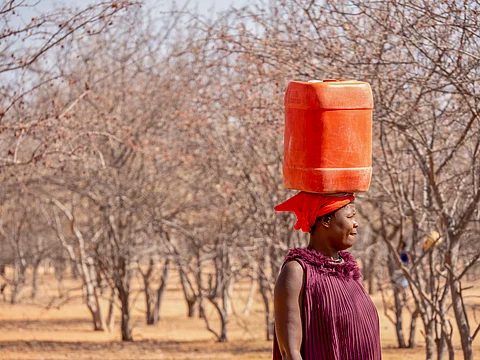

Namibia’s arid climate and dependence on rain-fed agriculture leave it highly vulnerable to climate change, with droughts and land degradation threatening food security.
The government has introduced national policies, strategies and community projects focusing on adaptation, mitigation and climate-smart agriculture.
Efforts include renewable energy expansion, rotational grazing, drought-resistant crops, water harvesting and participation in regional land restoration initiatives.
Namibia aims to cut greenhouse gas emissions by 91% by 2030 while mobilising international climate finance and raising public awareness through media engagement.
Namibia’s arid and semi-arid landscapes, combined with its heavy dependence on rain-fed agriculture, have made it one of the countries most vulnerable to the impacts of climate change in sub-Saharan Africa.
With rainfall varying widely from as little as 25 millimetres (mm) to 700 mm a year, the country endures frequent droughts and prolonged dry spells. This variability has slashed agricultural production, threatening food security in a nation whose economy relies heavily on natural resources, from crop and livestock farming to fisheries, biodiversity and mineral deposits.
“Namibia is highly vulnerable to the negative impacts of climate change due to its arid and semi-arid environment,” said Sion Shifa, a senior official in the Ministry of Environment, Forestry and Tourism’s climate change unit. “This vulnerability has the potential to reverse the country’s development gains.”
Shifa warned that key economic sectors including water resources, agriculture, biodiversity, tourism, health, energy and infrastructure are all exposed to climate-related risks. Prolonged droughts and creeping desertification are already reshaping the country’s landscapes and rural livelihoods.
Namibia has developed a suite of policies, projects and partnerships to tackle climate change at both national and community levels in spite of the challenges. It is a party to the United Nations Framework Convention on Climate Change and the 2015 Paris Agreement.
As early as 2001, Namibia established a multi-sectoral National Committee on Climate Change to advise the government. This was followed by the National Policy on Climate Change for Namibia in 2011, which identified priority areas for adaptation and mitigation, including public awareness, institutional strengthening and research.
To put the policy into action, the National Climate Change Strategy and Action Plan (2013-2030) was launched to reduce climate impacts on vulnerable communities and integrate climate considerations into development planning.
On the ground, interventions focus on food security, sustainable water use, biological resource management, agroforestry, rainwater and flood harvesting and climate-smart agriculture. Farmers are encouraged to plant drought-resistant crops, rear hardy livestock and adopt drip irrigation systems to conserve water.
Shetuuka Shetuuka, chair of the Olushandja Horticulture Producers Association, said local innovation was proving effective. “Our members are conserving water through drip irrigation and rainwater harvesting, planting drought-resistant crops such as carrots, beetroots, sweet potatoes and peppers and using organic fertilisers to revive the soil,” he said.
Community members receive training on sustainable farming techniques and advocate for policies to support small producers. Many rural households have established small to medium-sized gardens to boost food production and contribute to national food security.
To support environmental protection and climate action, Namibia created the Environmental Investment Fund (EIF) in 2001, which became operational in 2011 and is accredited to the Green Climate Fund. The EIF has mobilised more than N$460 million (about Rs 2.66 crore) in grants and readiness support for climate initiatives.
Climate-smart agriculture expert Axel Rothauge said traditional coping methods were becoming less effective. “For generations, Namibians have survived extreme weather through local knowledge,” he said. “But times are changing fast. Traditional methods are fading and new techniques are not always adapted to our environment.”
Rothauge noted that 15 per cent of Namibia is desert and 75 per cent is savannah, leaving it highly prone to desertification and rangeland degradation from continuous grazing in communal areas. He urged more rotational grazing and large-scale planting of indigenous tree species to protect landscapes.
Angus Mindleton, executive director of the Namibia Nature Foundation (NNF), said the country’s Nationally Determined Contributions were “quite ambitious”, aiming to cut greenhouse gas emissions by 91 per cent by 2030. NNF is implementing projects on agroforestry and climate-smart agriculture and is supporting the government in developing a National Adaptation Strategy to mainstream climate action.
Water scarcity is a critical concern. To address this, Namibia partnered with the International Atomic Energy Agency on a five-year project (2020-2024) to assess the impacts of climate change on groundwater resources in major aquifers in the country.
Namibia is also a party to the UN Convention to Combat Desertification and participates in continental initiatives such as the Great Green Wall Initiative and AFRI100, which aim to halt land degradation and restore millions of hectares of forest and savannah by 2030.
On the mitigation front, Namibia is promoting low-carbon development and renewable energy. In recent years, private investment in solar and wind energy has increased, supported by the National Policy on Renewable Energy, which seeks to expand access to clean energy in both urban and rural areas through off-grid and mini-grid systems.
In 2023, the country launched a National Carbon Market Framework to regulate carbon credit trading as part of efforts to cut emissions and finance climate action.
The government recognises that public awareness is critical. The National Policy on Climate Change encourages the media to actively report on the causes and impacts of climate change, as well as local adaptation and mitigation efforts.
To improve coverage, the Ministry of Environment, Forestry and Tourism has hosted multiple training sessions for journalists to strengthen reporting on climate science and policy.